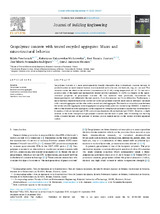Geopolymer concrete with treated recycled aggregates: Macro and microstructural behavior
Autor
Pawluczuk, Edyta
Kalinowska-Wichrowska, Katarzyna
Jiménez, José Ramón
Fernández Rodríguez, José María
Suescum-Morales, David
Editor
ElsevierFecha
2021Materia
Geopolymer concreteRecycled concrete aggregate
Construction and demolition waste
Alkali activation
Interfacial transition zone
METS:
Mostrar el registro METSPREMIS:
Mostrar el registro PREMISMetadatos
Mostrar el registro completo del ítemResumen
Geopolymer concrete is a more environmentally friendly alternative than conventional concrete because its production does not need cement. Instead, waste materials such as fly ash, rice husk ash, slag, etc. are used. This research studies the effect of the activator concentration (6–10 M), curing temperature (40–80 °C) and incorporation ratio of thermally and mechanically treated recycled aggregate (0–100%) on changes in the macrostructural properties of geopolymer concrete. All raw materials were previously characterized by thermogravimetric and differential thermal analysis, X-ray fluorescence and X-ray diffraction. Furthermore, a microstructural characterization was carried out on two geopolymer concrete mixes used as reference: one made with a natural aggregate and the other with a treated recycled aggregate. The interfacial transition zone between the treated recycled aggregate/natural aggregate and geopolymer paste was studied using SEM-EDS. A beneficial effect of the treated recycled aggregates on the compressive strength of geopolymer concrete was observed due to formation of silicate hydrated gel (CSH) and calcium aluminate silicate hydrated gel (CASH). However, a slight increase in the water absorption of geopolymer concrete and the mass of peels after 28 freezing and thawing cycles occurred because of the presence of residual porous cement mortar on the treated recycled aggregate surface.

